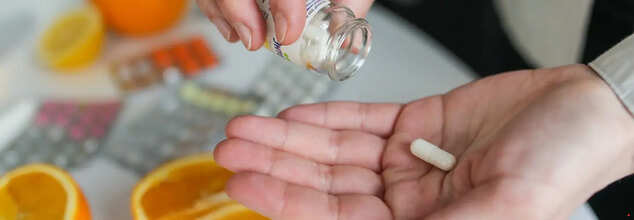
India’s First Indigenous Dengue Vaccine Coming Soon; What To Expect?
Dengue fever has been a public health crisis for decades, especially in tropical and subtropical regions, and India has been one of the worst-hit countries in recent years. With rising cases and fatal outbreaks, the country has required a reliable and inexpensive vaccine to prevent the spread of the disease. That changed with the launch of DengiAll, India's indigenous tetravalent dengue vaccine. After all these years of research, trials, and international collaboration, the vaccine is now in the last stage of testing, and a breakthrough seems at hand.
Developed by the Indian Council of Medical Research (ICMR) in collaboration with Panacea Biotech, DengiAll will be a game-changer for India's battle against dengue. The vaccine is currently in Phase 3 clinical trials, which are being conducted at 19 sites in 18 states and union territories with more than 10,335 healthy volunteers enrolled so far. The trials have shown promising results, with earlier phases (1 and 2) being successful for the vaccine to combat dengue across various strains.
The significance of the vaccine is not just its possibility in dengue prevention but also that it's an indigenous development, carefully crafted to fulfill India's needs. Balram Bhargava, former Director General of ICMR, who has played a key role in India's fight against COVID-19, ensured that India's first indigenous tetravalent dengue vaccine will be in the market by mid-2026—a landmark moment for India's health sector.
Dengue fever, transmitted by the Aedes aegypti mosquito, is one of the most common vector-borne diseases in India, especially prevalent during the monsoon season between May and September. The disease is characterized by fever, severe headache, joint pains, and sudden drop in platelet levels. It can, in severe cases, progress to dengue hemorrhagic fever (DHF) or dengue shock syndrome (DSS), which will prove fatal without urgent medical treatment. The World Health Organization (WHO) indicates that the worldwide incidence of dengue has grown eight times greater than two decades ago, thus emerging as a public health issue of major concern.
DengiAll is a tetravalent vaccine, and it has the goal of protecting against all four serotypes of the dengue virus (DENV-1, DENV-2, DENV-3, and DENV-4). This is a significant feature since dengue is a multi-serotype disease, and immunity to one serotype will not protect against others. In protecting against all four serotypes, the vaccine provides broad protection, which is extremely important in a country like India, where outbreaks are ever-present and in large part unpredictable.
The vaccine development is based on the TV003/TV005 strain, which was originally developed by the United States' National Institutes of Health (NIH). The strain was licensed to Panacea Biotech, a top Indian pharma company, and was adapted for domestic use. The company has achieved significant milestones in re-developing the vaccine to meet the specific needs of the Indian population, for whom it holds a process patent for development.
Highest Number of Cases Recorded In India
Approximately 188,401 cases were identified in 2017, with 325 deaths. Highest number of infections was reported from Tamil Nadu, followed by Kerala, Karnataka, then Punjab and West Bengal. In the 20th century, there was the significant rise in number of infections reported in 2003, 2010, 2012, and 2013, with an exponential increase beginning in 2015 onwards. During this time, repeated dengue outbreaks were reported in states of Andhra Pradesh, Goa, Delhi, Haryana, Karnataka, Gujarat, Kerala, Tamil Nadu, Punjab, and West Bengal. In 2017, dengue cases were to be the highest in India.
India, in particular, has experienced frequent outbreaks in West Bengal, Uttar Pradesh, Rajasthan, Bihar, Delhi, Kerala, and Tamil Nadu. The outbreaks have claimed thousands of lives and loaded the healthcare system with a great burden. Over 5 million cases of dengue have been reported to date as of 2023, with the Indian contribution playing a significant role in the surge. Since DengiAll is presently in its final stages of trials, the vaccine is set to reduce significantly the incidence of dengue and its complications in the country.
Why Dengue Cases Are On A Steady Rise?
Although India has been battling with dengue for years now, the illness has also been on the rise globally. The WHO states that the number of dengue cases reported globally has grown over twice in the past few years, with a total of 10.6 million cases having been reported thus far in the year 2024 alone. The growth is driven by various factors:
- Warm, humid temperatures offer ideal breeding grounds for mosquitoes.
- Overcrowded cities with poor waste management infrastructure facilitate the disease transmission.
- Increased international travel has led to dengue's expansion into non-endemic areas.
There is no cure for dengue known at the moment. It is treated with supportive care—hydration, management of fever, and close attention to platelet levels. If it is severe, hospitalization is required, and there are concerns regarding the burden this causes to the health system, especially in low-resource settings.
The presence of a dengue vaccine like DengiAll would be a welcome preventive. While a vaccine would not replace effective measures for mosquito control, it could be an extra tool in the public health arsenal, significantly reducing the number of severe cases and fatalities.
When Will Dengue Vaccine Hit the Market?
So far, DengiAll is in Phase 3 trials, and although it shows a great deal of promise, it should be kept in mind that the final approval phase could take time. If the ongoing trials continue to progress well, it is hoped that the vaccine would become available by mid-2026. This is a rough estimate, though, as it includes successful completion of the clinical trials and regulatory approvals.
Signs and Symptoms of Dengue Fever
Symptoms of dengue fever typically appear 4 to 10 days from the time of a bite from an infected mosquito and persist for 3 to 7 days. Asymptomatic cases are most common, but about 1 in 20 individuals will experience severe dengue when the initial symptoms start to resolve. Typical symptoms of dengue fever are:
- High fever
- Rash
- Severe pain behind the eyes
- Nausea and vomiting
- Muscle, bone, and joint pain
If you notice any of these symptoms, it is imperative that you receive medical care immediately, particularly if the symptoms are increasing.

Credit: Canva
UK Recalls Common Blood Pressure Drug Over Packaging Error
Patients taking a widely used blood pressure drug are being advised to verify their medication after a batch was recalled due to incorrect dosage information printed on the packaging. According to the Medicines and Healthcare Products Regulatory Agency (MHRA), some packs of lercanidipine, manufactured by Recordati Pharmaceuticals, have been wrongly labelled as containing 10mg tablets, when in fact they contain 20mg tablets.
Over 7000 Packs Are Subject To Recall
More than 7,700 packs already distributed are now subject to the recall, the MHRA has confirmed. Patients who may have the mislabelled medication are being urged to contact their GP, pharmacist, or call NHS 111 for advice. The NHS warns that consuming an excessive dose of lercanidipine can lead to symptoms such as dizziness and drowsiness. The MHRA issued the alert on Thursday after being informed by the Italian pharmaceutical company Recordati that the error was confined to a single batch of lercanidipine, which was initially distributed on April 10. The recalled packs carry the batch number MD4L07 and are marked with an expiry date of January 2028.
Although the front of the affected packs displays the incorrect strength, the correct 20mg dose is printed on the blister strips inside and on the side of some of the boxes. The MHRA advises patients who have been prescribed the 20mg dose to check the blister packaging to ensure they have received the correct medication. However, those prescribed 10mg tablets should seek immediate medical attention if they have this batch.
As a temporary measure, the MHRA suggests that patients who cannot reach a healthcare provider may take half of a 20mg tablet until they receive professional guidance. Dr Alison Cave, the MHRA’s chief safety officer, stated: "Healthcare professionals such as pharmacists are also being asked to stop supplying medicine from the affected batch and to return it to the supplier." She encouraged anyone experiencing suspected side effects to report them through the MHRA’s Yellow Card scheme.
In a statement to the BBC, a spokesperson for Recordati said the company is "working proactively" with the MHRA and will contact all customers who might have received the affected batch. “We are investigating the root cause and continue to work with our partners to isolate the issue and minimise disruption to our patients. Patient safety remains our top priority,” the spokesperson added.
What Do We Know About Lercanidipine?
Lercanidipine is used in the treatment of Angina (heart-related chest pain), Hypertension (high blood pressure), Arrhythmia, hypertensive emergency, subarachnoid haemorrhage and anal fissure. According to the NHS, it is one of the four types of blood pressure medicines sold across the UK. These pills are a calcium channel blocker. That means it regulates blood pressure by relaxing blood vessels and reducing pressure on them, thereby making it easier for the heart to pump more blood throughout the body. In this way, it normalises the blood pressure in patients with high blood pressure.
ALSO READ: RFK Jr.'s Autism Controversial Comments Face Backlash From Parents And Medical Experts

RFK Jr.'s Autism Controversial Comments Face Backlash From Parents And Medical Experts
Robert F. Kennedy Jr., the U.S. Secretary of Health and Human Services, is facing strong backlash after making sweeping comments during a recent press conference regarding autism and its supposed causes. As the CDC released a report revealing a rise in autism diagnoses among U.S. children now affecting 1 in 31 8-year-olds Kennedy doubled down on discredited theories linking autism to environmental exposures and vaccines, while portraying the disorder in stark, stigmatizing terms.
His remarks including claims that children with autism “will never hold a job,” “never pay taxes,” or “never use a toilet unassisted”, were swiftly condemned by parents, medical experts, and advocacy groups alike for reinforcing outdated stereotypes and misrepresenting the broad and diverse autism spectrum.
Autism spectrum disorder (ASD) is not a single condition with uniform symptoms or outcomes. Rather, it is a neurological and developmental condition characterized by challenges in social interaction, communication, and repetitive behaviors. The key word is "spectrum" and it exists for a reason.
Some individuals with autism may be nonverbal and need lifelong support, while others live independently, excel in careers, write books, or even hold public office. “Autism is not a disease,” said actress and autism advocate Holly Robinson Peete in a video statement, responding to Kennedy. “It is a developmental difference and it is important to get that right.”
Her son, RJ, diagnosed 25 years ago, has “shattered a lot of 'never' off that list,” she said, referring to Kennedy’s grim portrayal. Countless parents echoed this sentiment on social media, stating that Kennedy’s generalizations erase the lived realities, milestones, and accomplishments of their children.
CDC Data Shows a Rise in Diagnoses
The CDC’s Autism and Developmental Disabilities Monitoring (ADDM) Network reported that 1 in 31 8-year-olds in the U.S. were diagnosed with autism in 2022, compared to 1 in 54 in 2016. But experts stress that this increase is not necessarily cause for alarm. It is, in fact, a sign of progress.
The rise in autism rates is driven largely by improved awareness, broader diagnostic criteria, and increased access to evaluations and services. We are identifying children earlier and more accurately that’s a good thing.
Kennedy, however, rejected this explanation as “indefensible” and announced plans for a directive to the National Institutes of Health to investigate “environmental exposures” as the root cause — reigniting long-debunked concerns about vaccines and toxins.
Despite overwhelming scientific consensus debunking any link between vaccines and autism, Kennedy has long been associated with promoting vaccine hesitancy. His latest comments, veiled in language about “environmental exposures,” once again hint at this discredited narrative.
Leading medical organizations, including the American Academy of Pediatrics and the World Health Organization, have repeatedly emphasized that vaccines are safe, effective, and have no causal relationship with autism. Resurrecting these claims only spreads fear and confusion. It undermines public health and harms autistic people by framing their existence as a preventable tragedy.
Parents Demand a Shift in the Narrative
Perhaps the strongest rebuke came from parents of autistic children themselves. Samantha Taylor, whose 20-year-old son is on the spectrum, told Good Morning America, “Autism doesn’t destroy families misinformation does.” In a viral Facebook post, she added, “What truly causes damage is the relentless portrayal of autism as something catastrophic, rather than a different way of experiencing the world.”
Kennedy’s comments, they say, not only ignore the complexity of the condition but strip children of their dignity and potential.
“Statements like ‘they’ll never write a poem’ deny the creative genius that so many autistic individuals demonstrate,” said Peete. “It’s dangerous, it’s harmful, and it’s simply false.”
Experts Call for More Informed Leadership
While Kennedy has promised answers by September through federally backed studies, medical experts warn that his rhetoric may set back years of advocacy and research by framing autism as an “epidemic” akin to an infectious disease.
Autism is not something to be eradicated, it’s something to be understood, supported, and embraced. Families deserve resources, not fearmongering.
In the last two decades, the medical community has shifted toward neurodiversity — a perspective that recognizes neurological differences like autism as natural variations of the human genome. This philosophy emphasizes inclusivity, respect, and strength-based approaches rather than medicalizing difference.
At a time when public trust in institutions is fragile, the words of public officials matter deeply. Kennedy’s comments have triggered a reckoning not only about how autism is portrayed in the media and politics but also about how society chooses to value — or devalue — people who are different.
Advocates stress the need for policies rooted in science, not stigma, and for leadership that uplifts rather than marginalizes.
As the national conversation around autism continues, one thing is clear: the autism community — parents, children, adults on the spectrum, clinicians, and allies — is not going to stay silent in the face of outdated narratives.

Credits: Canva
World Liver Day: How A Timely Liver Transplant Saved A 30-Year-Old Man
On World Liver Day, which is observed on April 19, to spread awareness about liver health and the life-saving power of organ donation, let us look at one such real-life story. This is where doctor's prompt's action and one's selfless donation saved one human's life.
When the 30-year-old Delhi-based man walked into the hospital, he had yellow eyes and dangerously high liver enzymes. He was admitted in Max Super Speciality Hospital, Patparganj. That moment, he rarely knew that his life was, in fact, hanging by a thread. The man was diagnosed with acute liver failure, which was caused by viral hepatitis. His body was slowly shutting down. The frequency of his body shutting down had increased. The doctors also quickly informed the family. This was the one last hope of survival - a liver transplant.
The First Option Failed
His sister was family's first ray of hope. She was also willing and had a compatible liver whose part of it could be donated. However, pre-surgery tests revealed that her liver size was too small to ensure a safe transplant. The family then proposed the patient's brother-in-law - a second-degree relative, as the next donor. His liver was a better match, but since he was not an immediate blood relative, there had to be special regulatory approvals which were required.
However, the worsening condition of the patients allowed no such time.
The hospital too scrambled to get clearance for the brother-in-law. All this while, the patient suffered a cardiac arrest. The situation turned dire within minutes. Doctors performed CPR to revive him. He was immediately put on ventilator support. The decision had to be taken soon.
A Miraculous Surgery
With no time in hand, the doctors decided to go ahead with the sister as the donor, though there were risks there too.
A team of highly skilled hepatobiliary surgeons, anesthesiologists, and critical care specialists took over. In a high-risk, nine-hour surgery, they removed the patient’s failing liver and replaced it with part of his sister’s.
“This was one of the most challenging cases we’ve handled,” said Dr. Ajitabh Srivastava, Director – HPB Surgery & Liver Transplant. “When the patient collapsed, our team acted within seconds. Every decision, every move mattered. His survival was truly a team triumph.”
The patient is now recovering well.
What Is A Liver Transplant?
As per the National Institute of Diabetes and Digestive and Kidney Diseases, a liver transplant is a surgical procedure to replace a diseased liver with a healthy one from a donor. It’s often the last resort when liver failure occurs—whether due to chronic illness or sudden injury.
When Is It Needed?
People may need a liver transplant for:
- Alcoholic liver disease
- Fatty liver disease (NASH)
- Cirrhosis due to chronic hepatitis C
- Liver cancer with cirrhosis
- Acute liver failure (often due to drug overdose, hepatitis, or toxins)
Types of Liver Transplants
Deceased Donor Transplant:
The most common type, where a full or partial liver is taken from someone who has recently died.
Living Donor Transplant:
A healthy person donates a portion of their liver—typically a close relative. Both the donor’s and recipient’s liver regenerate to normal size in a few weeks.
What Must Be Kept In The Mind?
- Matching and Compatibility: Blood type, liver size, and health are crucial.
- Approval Process: Especially important for non-blood relatives.
- Recovery and Monitoring: Post-op care involves lifelong medication, lifestyle changes, and regular check-ups.
© 2024 Bennett, Coleman & Company Limited

